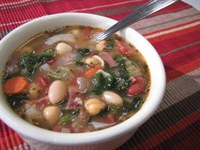Prairie Fare: Eat Right with Color During March, National Nutrition Month
(Click an image below to view a high-resolution image that can be downloaded)
By Julie Garden Robinson, Food and Nutrition Specialist
NDSU Extension Service
“Mom, I’m growing corn, strawberries, tomatoes, pumpkin and cabbage in my garden. Farm-fresh fruits and vegetables are good for my pet,” my 7-year-old daughter said as she showed me her computer game in our home office.
“Fruits and vegetables are good for you, too,” I replied. I waited for her to decide what her virtual pet dachshund should wear for the day.
“I was growing watermelon, but I needed to make my garden smaller. I can save money by growing my own fruits and vegetables,” she noted as she read some tips in the online storybook.
I was intrigued with this game, which promoted growing and eating fruits and vegetables. She gained access to the game with our purchase of a toy.
“You’re really growing a rainbow of colorful produce. You already have red, orange, yellow and green ones. Are there any seeds for purple fruits or vegetables?” I asked.
“No, but you can buy plums at the store. Look how big that green cabbage is. I’ll try to harvest it!” she exclaimed as she manipulated the computer mouse and inspected her garden.
The plant growth indicator showed her virtual garden was doing well. She clicked on the harvest icon and attempted to cut her cabbage, but the crate wouldn’t fill.
“The cabbage isn’t ready. The corn takes two weeks before I can harvest it, too,” she announced.
Knowing of her interest in virtual gardening, I bought her a kit to grow a real indoor garden the previous day. Upon hearing the news, she was ready to plant immediately.
She took my hand and led me into the kitchen to read the instructions. We made tiny signs using toothpicks and notepaper. She was very excited to handle tomato, cilantro and cayenne pepper seeds.
Kids who help grow a garden are more likely to sample the produce, according to research and according to my own experience with my other children.
Whether you start seeds now and plant your own garden this spring or buy your fruits and vegetables at a grocery store or farmers market, plan to include a variety of colors in your menu.
This year’s theme of the American Dietetic Association’s National Nutrition Month campaign is “Eat right with color.” More information is available at http://www.eatright.org/nnm.
Scientists are regularly reporting new health benefits associated with fruits and vegetables. People who eat more generous amounts of fruits and vegetables as part of a healthy diet are likely to have a reduced risk of chronic diseases, including strokes, type 2 diabetes, some types of cancer, and possibly heart disease and high blood pressure.
Do your produce choices resemble the rainbow? As you may remember from grade school, “Roy G. Biv” is an acronym to help us remember the colors of the rainbow: red, orange, yellow, green, blue, indigo and violet.
Here are some examples from the spectrum of rainbow-colored fruits and vegetables and a recipe that puts the information into practice. For more information, see “What Color is Your Food?” available at http://www.ag.ndsu.edu/pubs/yf/foods/fn595.pdf.
- Red: apples, red cabbage, cherries, cranberries, raspberries, red grapes, red peppers, red potatoes, rhubarb, strawberries and watermelon
- Orange: cantaloupe, carrots, oranges, peaches, pumpkin, squash, sweet potatoes and tangerines
- Yellow: yellow apples, corn, lemons, pears, yellow peppers, pineapple and yellow tomatoes
- Green: green apples, artichokes, asparagus, green beans, broccoli, brussels sprouts, cabbage, cucumbers, green grapes, kiwi, lettuce, peas, green pepper and spinach
- Blue/Indigo/Violet: blackberries, blueberries, eggplant, figs, juneberries, plums, prunes, purple grapes and raisins
- Don’t forget to include some white vegetables on your menu, too. These include cauliflower, garlic, jicama, onions, parsnips, potatoes and turnips.
Rainbow Stew
2 c. diced yellow onions
4 cloves garlic, minced
1 c. diced celery
1 c. diced carrots
1 Tbsp. olive oil or salad oil
1 14-ounce can diced tomatoes
1 14-ounce can light red kidney beans, drained and rinsed
1 14-ounce can chickpeas, drained and rinsed
1 14-ounce can cannellini beans, drained and rinsed
8 c. low-sodium chicken broth, plus extra water if needed
1 tsp. each of dried oregano, dried thyme and dried basil
2 bay leaves
1 c. dry mini pasta shells
1/4 c. frozen chopped spinach, thawed and squeeze-dried (optional)
Pepper (to taste)
Grated parmesan cheese (optional)
In a large pot, sauté the onion, garlic, celery and carrots in 1 Tbsp. of oil until soft. Add tomatoes, cannellini beans, chickpeas, kidney beans, chicken broth and spices. Bring to a boil. Reduce heat and simmer 20 minutes. Cook pasta in separate kettle as directed on package. Rinse with cold water. Remove bay leaves. Finely chop spinach. Add spinach and pasta to soup. Serve with a sprinkle of parmesan cheese if desired.
Makes 12 servings. Each serving has 150 calories, 3 grams (g) of fat, 7 g of protein, 22 g of carbohydrate, 440 milligrams of sodium and 5 g of fiber. It also provides vitamins A and C.
(Julie Garden-Robinson, Ph.D., L.R.D., is a North Dakota State University Extension Service food and nutrition specialist and associate professor in the Department of Health, Nutrition and Exercise Sciences.)
NDSU Agriculture Communication – Feb. 24, 2011
| Source: | Julie Garden-Robinson, (701) 231-7187, julie.garden-robinson@ndsu.edu |
|---|---|
| Editor: | Rich Mattern, (701) 231-6136, richard.mattern@ndsu.edu |



